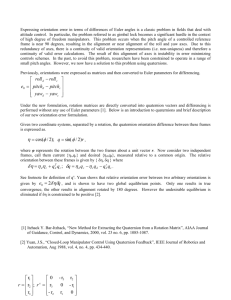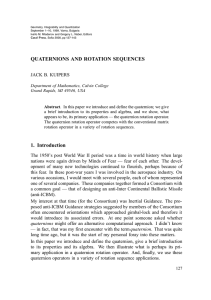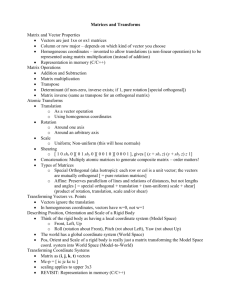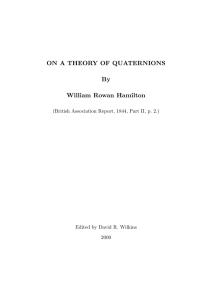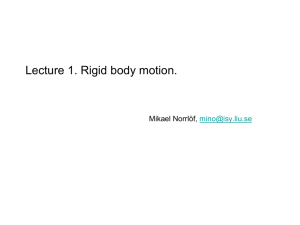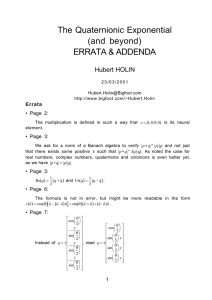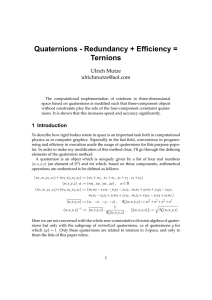Some
advertisement
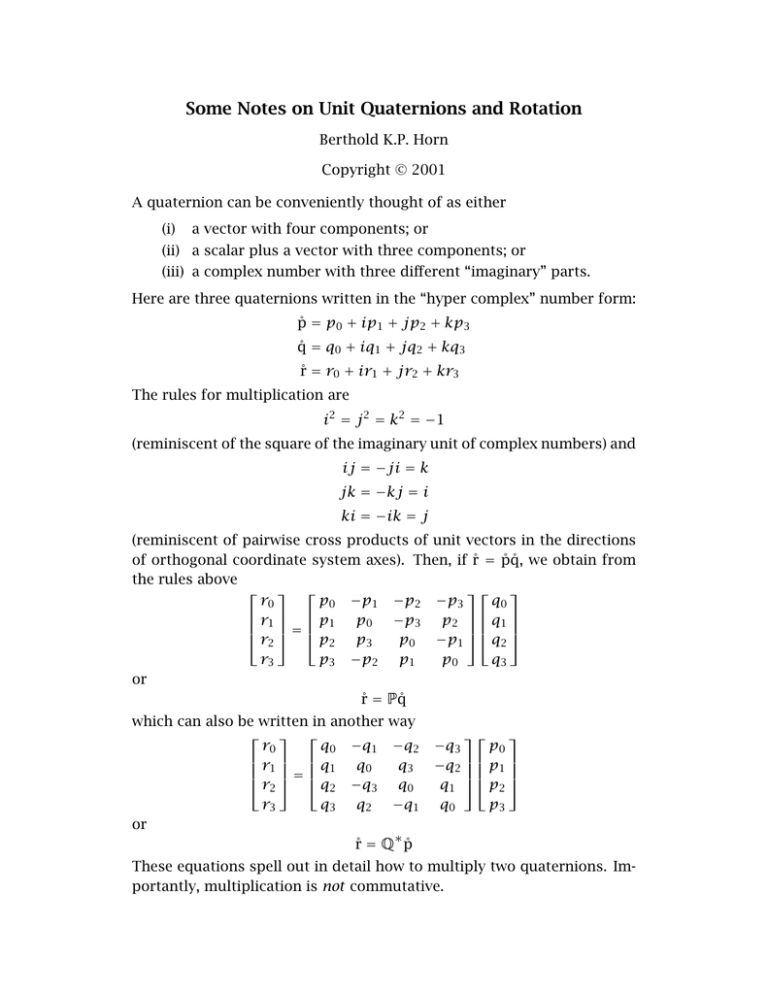
Some Notes on Unit Quaternions and Rotation Berthold K.P. Horn Copyright © 2001 A quaternion can be conveniently thought of as either (i) a vector with four components; or (ii) a scalar plus a vector with three components; or (iii) a complex number with three different “imaginary” parts. Here are three quaternions written in the “hyper complex” number form: p̊ = p0 + ip1 + jp2 + kp3 q̊ = q0 + iq1 + jq2 + kq3 r̊ = r0 + ir1 + jr2 + kr3 The rules for multiplication are i2 = j 2 = k2 = −1 (reminiscent of the square of the imaginary unit of complex numbers) and ij = −ji = k jk = −kj = i ki = −ik = j (reminiscent of pairwise cross products of unit vectors in the directions of orthogonal coordinate system axes). Then, if ˚ r = p˚ ˚q, we obtain from the rules above ⎡ ⎤ ⎡ ⎤⎡ ⎤ r0 p0 −p1 −p2 −p3 q0 ⎢r ⎥ ⎢p ⎥ ⎢ ⎥ ⎢ 1 ⎥ ⎢ 1 p0 −p3 p2 ⎥ ⎢ q1 ⎥ ⎢ ⎥=⎢ ⎥⎢ ⎥ ⎣ r2 ⎦ ⎣ p2 p3 p0 −p1 ⎦ ⎣ q2 ⎦ r3 p3 −p2 p1 q3 p0 or ˚ r = Pq ˚ which can also be written in another way ⎡ ⎤ ⎡ r0 q0 −q1 −q2 ⎢r ⎥ ⎢q q3 ⎢ 1 ⎥ ⎢ 1 q0 ⎢ ⎥=⎢ ⎣ r2 ⎦ ⎣ q2 −q3 q0 r3 q3 q2 −q1 or ˚ r = Q∗ p ˚ ⎤⎡ ⎤ −q3 p0 ⎥⎢p ⎥ −q2 ⎥ ⎢ 1⎥ ⎥⎢ ⎥ q1 ⎦ ⎣ p2 ⎦ q0 p3 These equations spell out in detail how to multiply two quaternions. Importantly, multiplication is not commutative. 2 Note that the matrices appearing above are orthogonal, in fact PPT = p · p) (˚ ˚ I where I is the 4 × 4 identity matrix. The above gives two useful isomorphisms between quaternions (˚ p and q) ˚ with orthogonal 4 × 4 ∗ matrices (P and Q ) — one for “pre-multiplication” and one for “postmultiplication.” “Scalar plus Vector” notation Using the more compact “scalar plus vector” notation, we can write, p ˚ = (q, q), ˚ = (p, p), q r = (r , r) and ˚ so that the product (r , r) = (p, p)(q, q) becomes (r , r) = (pq − p · q, pq + qp + p × q) We now define the conjugate of a quaternion q̊ ∗ = (q, −q) where q̊ = (q, q), and the dot-product of two quaternions p ˚·q ˚ = pq + p · q It is useful to derive a few identities based on these basic operations: (˚q) p˚ ∗ = q ˚∗ ˚∗ p (˚q) ˚ q ·˚ p˚ · (˚r) p˚ = (˚ p · p)(˚ r) p˚ · (˚q) p˚ = (˚ p · p)(˚ ˚ (˚q) ˚ q · q) ˚q · ˚ ˚ · ˚q r˚∗ p˚ r=p Importantly if q ˚ = (q, q) and q ˚∗ = (q, −q), then ˚·q ˚∗ = (˚ q q · q)˚ ˚ e where ˚ e = (1, 0). Hence q ˚∗ /(˚ ˚ is the inverse of q, q · q) ˚ that is ∗ q ˚ /(˚ ˚ q ˚=˚ e q · q) and ∗ q ˚ q ˚ /(˚ ˚ =˚ e. q · q) This is a manifestation of the interesting algebra of quaternions — something not possible with vectors of three components (i.e. there is no sensible definition for multiplication for vectors that yields interesting properties such as an inverse). Representing vectors and rotations We use quaternions with zero “real” part to represent vectors. So the vector r is represented by r̊ = (0, r). Consider the transformation of r to r performed by r = q˚q ˚r˚∗ ˚ 3 where ˚ r is a “purely imaginary” quaternion (i.e. ˚ r = (0, r)) and q ˚ is a unit quaternion (i.e. q ˚·q ˚ = 1). Applying the above rule for multiplication of quaternions twice we find first that the “real” part of the result is zero, so that we can write ˚ r = (0, r ), and second r = (q2 − q · q)r + 2q(q × r) + 2(q · r)q. a result that can also be written in an alternate form that involves fewer arithmetic operations: r = r + 2q(q × r) + 2q × (q × r). The operation ˚ r = q˚q ˚r˚∗ turns a “purely imaginary” quaternion into another purely imaginary quaternion. The inverse of this operation is simply r=q ˚ ˚∗˚ r q. ˚ It is easy to show that the operation preserves dot-products. That is, r1 · r2 = r1 · r2 where ˚ r1 = q˚ ˚r1 q ˚∗ and ˚ r2 = q˚ ˚r2 q ˚∗ . A special case of this is r · r = r · r. This means the operation preserves lengths and angles. It must therefore be a rotation — or a rotation plus a reflection. Finally, we can show that the operation preserves triple products [r1 r2 r3 ] = [r1 r2 r3 ] and hence must represent a rotation, since a rotation plus reflection would flip the sign of the triple product. It remains for us to figure out what rotation the unit quaternion q̊ q · q) represents. Substituting q for r in the above formula yields (˚ ˚ q or r = q. Hence q is parallel to the axis of rotation ω. We still need to determine the angle of rotation θ. A vector r perpendicular to the axis of rotation is turned into a vector r making an angle θ with r. If we pick r = q × a where a is an arbitrary vector that is not parallel to q, then we find after some simplification that r · r = (q2 − q · q) r2 Now since r · r = r r cos θ and r = r we find that q2 − q · q = cos θ adding q2 + q · q = 1 to this equation we obtain 2q2 = 1 + cos θ or q = ± cos(θ/2). If we subtract, we obtain instead 2q · q = 1 − cos θ or q = sin(θ/2). So finally q = ± sin(θ/2)ω 4 Hence the unit quaternion representing rotation through an angle θ about the axis ω is q̊ = (q, q), with q and q are as defined above. Note, however, that −q̊ represents the same rotation, since (−˚ r(−˚ q)˚ q ∗ ) = q˚q ˚r˚∗ . Finally, from p(˚r˚ ˚ q˚q ∗ )˚ p∗ = (˚q)˚ q∗ p ˚∗ ) = (˚q)˚ p˚ r(˚ p˚ r(˚q) p˚ ∗ we see that composition of rotations corresponds to multiplication of quaternions. Advantages of unit quaternion notation There are at least eight methods used fairly commonly to represent rotation, including: (i) orthonormal matrices, (ii) axis and angle, (iii) Euler angles, (iv) Gibbs vector, (v) Pauli spin matrices, (vi) Cayley-Klein parameters, (vii) Euler or Rodrigues parameters, and (viii) Hamilton’s quaternions. One advantage of the unit quaternion representations is that it leads to a clear idea of what the “space of rotations” is — we can think of it as the unit sphere in 4-space with antipodal points identified (−q̊ represents the same rotation as q̊). This makes it possible, for example, to compute averages over all possible attitudes of an object. It also makes it possible to sample the space of rotations in a systematic way — or randomly — with uniform sampling density. Another advantage is that, while redundant (4 numbers to represent 3 degrees of freedom), the extra constraint (namely that it has to be a unit quaternion) is relatively easy to deal with. This makes it possible to find closed-form solutions to some optimization problems involving rotations. Such problems are hard to solve when using orthonormal matrices to represent rotation because of the six non-linear constraints to enforce orthonormality (R T R = I), and the additional constraint det(R) = +1. If we compose rotations using multiplication of 3 × 3 matrices, numerical problems will conspire to make the results not quite orthonormal. It is difficult to find the “nearest” orthonormal matrix to one that is not quite orthonormal. Mutliplying unit quaternions may lead to quaternions that are no longer of unit length, but they are easy to normalize. When it comes to rotation vectors and composing rotations, quaternions may have less of an advantage. While it takes fewer operations to multiply two unit quaternions than it does to multiply two orthonormal matrices, it takes a few more operations to rotate a vector using unit quaternions (although the details depend in both cases on how cleverly the operation is implemented).
